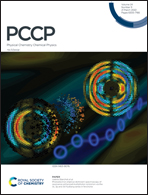Cu2+-Induced self-assembly and amyloid formation of a cyclic d,l-α-peptide: structure and function†
Abstract
In a wide spectrum of neurodegenerative diseases, self-assembly of pathogenic proteins to cytotoxic intermediates is accelerated by the presence of metal ions such as Cu2+. Only low concentrations of these early transient oligomeric intermediates are present in a mixture of species during fibril formation, and hence information on the extent of structuring of these oligomers is still largely unknown. Here, we investigate dimers as the first intermediates in the Cu2+-driven aggregation of a cyclic D,L-α-peptide architecture. The unique structural and functional properties of this model system recapitulate the self-assembling properties of amyloidogenic proteins including β-sheet conformation and cross-interaction with pathogenic amyloids. We show that a histidine-rich cyclic D,L-α-octapeptide binds Cu2+ with high affinity and selectivity to generate amyloid-like cross-β-sheet structures. By taking advantage of backbone amide methylation to arrest the self-assembly at the dimeric stage, we obtain structural information and characterize the degree of local order for the dimer. We found that, while catalytic amounts of Cu2+ promote aggregation of the peptide to fibrillar structures, higher concentrations dose-dependently reduce fibrillization and lead to formation of spherical particles, showing self-assembly to different polymorphs. For the initial self-assembly step to the dimers, we found that Cu2+ is coordinated on average by two histidines, similar to self-assembled peptides, indicating that a similar binding interface is perpetuated during Cu2+-driven oligomerization. The dimer itself is found in heterogeneous conformations that undergo dynamic exchange, leading to the formation of different polymorphs at the initial stage of the aggregation process.



 Please wait while we load your content...
Please wait while we load your content...